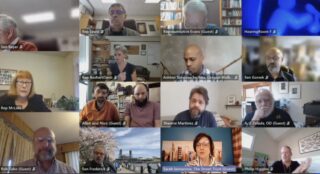
Senate Bill 395, also known as the Safe Routes for All bill, got its first hearing at the Oregon Legislature this morning where members of the Joint Transportation Committee heard much more support for the bill than opposition to it.
But what the opposition lacked in the collective power of their voices, they made up for in the power of the organizations they spoke up for.
Proposed by The Street Trust with sponsorship from Eugene-area Senator Floyd Prozanski (who was not in attendance today), SB 395 seeks to increase the minimum expenditure on bicycling and walking infrastructure from the State Highway Fund from 1% to 5% and make a few other key tweaks to what’s known as the Oregon Bike Bill, a groundbreaking piece of legislation passed in 1971.
Advertisement
“Not a single community in Oregon can boast a complete bike and pedestrian network.”
— Sarah Iannarone, The Street Trust
“It’s an unfunded mandate in the form of a diversion of 4% of county road budgets.”
— Mallorie Roberts, Association of Oregon Counties
Dozens of transportation advocates from across Oregon expressed strong support for the bill at this morning’s hearing. They shared the myriad benefits of walking and biking as well as personal stories of crashes and tragedies due to a lack of safe infrastructure.
Sarah Iannarone, interim executive director at The Street Trust reminded lawmakers that bicycle tourism brings $400 million to Oregon’s economy and that bike-related jobs are a boon for the economy. But all that is in jeopardy, she explained, because of a lack of investment. “Not a single community in Oregon can boast a complete bike and pedestrian network,” she said in her testimony, “These conditions make it dangerous for people who do not have access to a car, saddle households with the expense of car ownership, deprive young people and people with disabilities of independent mobility and physical activity, and increase particulate pollution and greenhouse gas emissions.”
Portlander Michelle DuBarry delivered powerful words about how her husband and 22-month-old son Seamus were hit by a driver while walking in a crosswalk. “[Our toddler] had two surgeries and died the next day,” DuBarry shared. “This crash, like so many others, could have been prevented with simple infrastructure improvements.”
Advertisement
“[SB 395] clearly flies in the face of the equitable distribution of cost responsibility.”
— Mark Gibson, Oregon Trucking Association
Casey Kulla (who’s a Yamhill County Commissioner by day but testified as a private party) said he supports the bill because it would give smaller rural areas more power on what type of investments to make. “Raising the minimum to 5% is one of best ways to give communities local control over effective amounts of money to do safety improvements… I hope you’ll prioritize safety of people, even if they cannot afford a car,” he said.
Wheelchair user Nico Serra shared his story of being hit and dragged down the road by a car user while bicycling in 2010. “I was following all the rules. I was wearing a helmet. I was on the right side of the road. And yet doing everything right didn’t save me from a careless driver… And with a moment’s notice I went from being an athletic, able-bodied person to needing a power-chair to get around.” Serra shared that as a wheelchair user, the presence of quality curb ramps and sidewalks are the deciding factor of whether or not he can access public spaces.
As clear as the need for quality biking and walking infrastructure is, the thought of allocating more State Highway Fund monies to it is a non-starter for several powerful organizations.
In written and spoken testimony, lawmakers have been put on notice that some of Oregon’s most well-known interest groups are opposed to SB 395. They include: Association of Oregon Counties, League of Oregon Cities, Oregon Trucking Association, and the Association of General Contractors.
Oregon Trucking Association lobbyist Mark Gibson made the argument that bicycle users and walkers don’t pay enough into the system. “[SB 395] clearly flies in the face of the equitable distribution of cost responsibility that the state has held so dear for so long.” What about the bike tax passed in 2017 that was supposed to thwart this argument? Gibson called it a “modest” tax and said, “In no way does revenue from this tax come close to paying for the costs imposed by bicycles and pedestrians in the system.”
Mallorie Roberts, a lobbyist for the Association of Oregon Counties and Oregon Association of County Engineers and Surveyors, expressed concerns that the bill would siphon funds from maintenance project, “Because it includes an unfunded mandate in the form of a diversion of 4% of county road budgets.”
A rep for the League of Oregon Cities said the bill should be tabled and only discussed as part of a comprehensive transportation package.
Marie Dodds, president of AAA Oregon-Idaho didn’t take a position on the bill. Her carefully-worded, neutral testimony made it clear AAA is concerned about pressures on the State Highway Fund, but they don’t want to take sides. “It’s well documented that there are currently not enough revenues to pay for the maintenance and preservation of our existing transportation system,” Dodds said, after listing all the ways AAA supports bicycling.
One recurring theme of opposition is a section in the bill that would add “resurfacing” projects to the list of project types that would trigger the minimum spending requirement (currently limited to major road reconstructions). House Rep. Paul Evans (D-Monmouth) worried that, “If the language of this bill is interpreted to include slurry and chip seals as ‘resurfacing,’ then the pavement maintenance funding will be severely reduced.”
Evans’ concerns were echoed by several organizations who oppose that section of the bill, including the Oregon chapter of the American Planning Association, who said in written testimony that, “This added requirement could result in an inability to maintain roadways pending creation of new funding sources.”
Unfortunately no one was on-hand to answer Rep. Evans’ question. An aide to Senator Prozanski said she’d learn more and report back.

While there wasn’t much substantive discussion or debate from lawmakers today, one retired lawmaker stole the show.
Al Densmore, 74, served in the state legislature from 1971 to 1975 and was mayor of Medford for six years. He was also a co-sponsor of the original Bike Bill and personal friend of its creator Don Stathos. “I’m here to provide some historical context,” he said.
“Don came by my desk after a floor session and said, ‘I have this little bill here I’d like to have you consider. It’s a simple bill. It’s primarily designed for safety because my daughter and I were almost killed on Jacksonville Highway while riding our tandem, but we don’t have any part of our highway system funding that speaks to bicycle and pedestrian needs. So this is a simple bill, but it has a powerful idea.'”
Densmore then shared how the 1971 bill has 11 co-sponsors — seven Republicans and four Democrats — and that it was opposed by the highway committees in the House and Senate and nearly vetoed by Oregon Highway Commission Chair Glenn Jackson who, according to Densmore, said, “It was something we couldn’t afford.”
“I’d like to say that 50 years later,” Densmore continued. “We’re about hopefully to emerge from a pandemic, and our whole transportation system will likely have to be re-thought. And I think now’s the time to update the bicycle bill.”
— Jonathan Maus: (503) 706-8804, @jonathan_maus on Twitter and jonathan@bikeportland.org
— Get our headlines delivered to your inbox.
— Support this independent community media outlet with a one-time contribution or monthly subscription.


